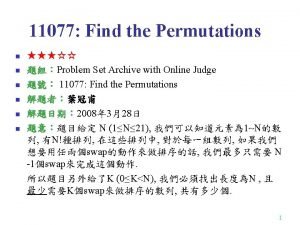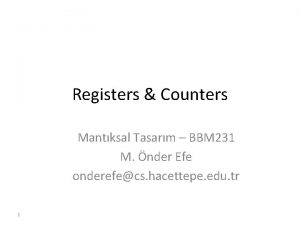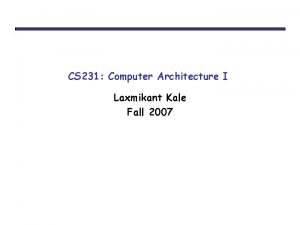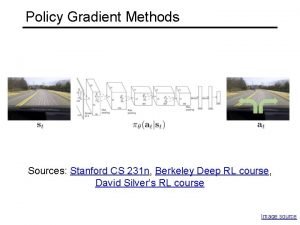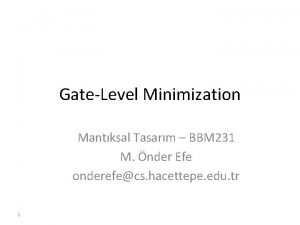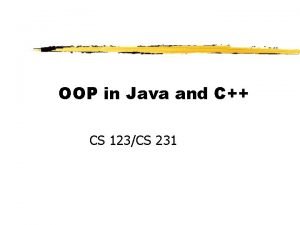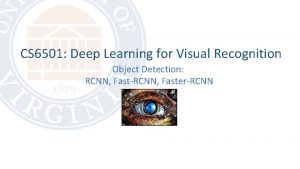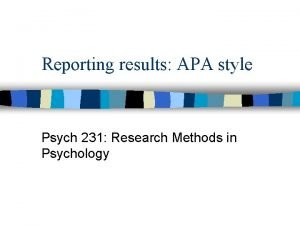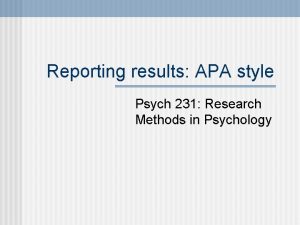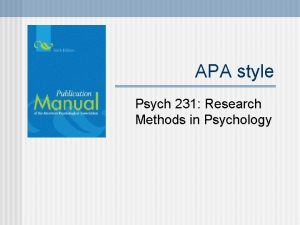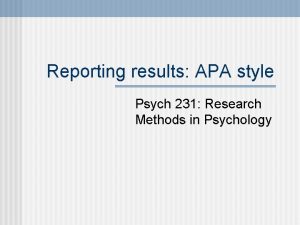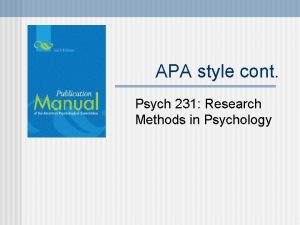Finish up APA style Ethics Psych 231 Research






















- Slides: 22

Finish up APA style Ethics Psych 231: Research Methods in Psychology

n n Quiz 4: Due Fri. Feb. 5 (by midnight) Exam 1: on Tuesday n Mixture of multiple choice and short answer n University college writing help: n http: //www. ucollege. ilstu. edu/tutoring/writing/ Online CITI ethics training due week 5 n n http: //psychology. illinoisstate. edu/jccutti/psych 231/f 16/fall 2016 ethics. html Announcements

n The basic parts of a research article: • Abstract • Body • Introduction • Methods • Participants • Materials/Apparatus • Design • Procedure • Results • Discussion • References • The rest • Authors Notes, Footnotes, Tables, Figures & Captions APA style: Parts of a research report

n References (video | video) n n Author’s name Year Title of work Publication information • Journal • Issue • Pages n n n Footnotes Tables Figures Adolescent Depression 29 References Barnett, P. A. , & Gotlib, I. H. (1988). Psychosocial functioning and depression: Distinguishing among antecedents, concomitants, and consequences. Psychological Bulletin, 104, 97 -126. Beck, A. T. (1978). Beck Depression Inventory. San Antonio, TX: Psychological Corporation. Benoit, D. , Vidovic, D. , & Roman, J. (1991, April). Transmission of attachment across three generations. Paper presented at the Biennial Meeting of the Society for Research in Child Development, Boston. Benoit, D. , Zeanah, C. H. , & Barton, M. L. (1989). Maternal attachment disturbances in failure to thrive. Infant Mental Health Journal, 3, 185 -202. Benoit, D. , Zeanah, C. H. , Boucher, C. , & Minde, K. (1989). Sleep disorders in early childhood: Association with insecure maternal attachment. Journal of the American Academy of Child and Adolescent Psychiatry, 31, 86 -93. When something odd comes up, don’t guess. Look it up! The rest

n n n These are used to supplement the text. To make a point clearer for the reader. Typically used for: n n n The design Examples of stimuli Patterns of results Figures and tables

Clarity Logic of the argument is clear Acknowledge the work of others (avoid plagiarism) Appropriate use of headings Correct citing and references Good grammar Active (preferred) vs. passive voice (avoid) n n How are pieces related, clear transitions between paragraphs Active: Summers and Jordan (2009) hypothesized that speakers use to much passive voice Passive: It was hypothesized by Summers and Jordan (2009) that speakers use to much passive voice Avoid biased language Checklist - things to watch for

Ethics – people should be treated as ends not means Ethics

n Two basic categories of ethical concerns: n n Need to consider the rights of our participants in our research Need to behave ethically as scientists and practitioners Ethical Responsibilities in Research

n Two basic categories of ethical concerns: n n Need to consider the rights of our participants in our research Need to behave ethically as scientists and practitioners Ethical Responsibilities in Research

n For the most part the researcher has the power • You know what is going to be done to the participants • Participants may feel like they have to do it • Consider the Milgram (1963) study • demonstrated how far people may go to obey authorities • This study itself exemplifies the need for strict rules of ethics Using humans in research

n Consider ethics at each step n n n n Does the topic/idea for the research have some ethical issues surrounding it? How are participants selected? What methods may be used on the participant population? What measurement techniques will be used? What design is appropriate? How are the data analyzed? How are the results reported? Ethical Responsibilities in Research

APA’s code of ethics http: //www. apa. org/ethics/code/index. aspx

5 General Principles (& many ethical standards) A. Beneficence & Non-maleficence • B. Fidelity & Responsibility • C. Honesty and accuracy in science Justice • E. Uphold professional and scientific standards of contact Integrity • D. Protection from harm, Cost/Benefits analysis, Confidentiality Freedom from coercion Respect for people’s rights and dignity • Basic courtesy, Informed consent, Debriefing, Avoid deception APA’s code of ethics http: //www. apa. org/ethics/code/index. aspx

n Information to allow a person to decide if they want to participate (sample in lab manual pgs 26 -27) n Basic purpose of the study Participation is voluntary Risks involved Benefits involved Rights to refuse or terminate participation n Assent - guardians if participants are not competent n n • e. g. , children, developmentally disabled people Informed consent

n Types n Passive deception • Withholding information about the study n Active deception • Deliberately misleading participants n Avoid it when possible n Consider alternatives to deception • Role-playing n When not possible to avoid n n n Make sure that you are up front with all possible risks Potential results must be worth it Must debrief participants as soon as possible (either right after participation or as soon as project is over) Using deception in research

n Costs: all potential risks to the participants n n Physical harm Psychological harm Loss of confidentiality Benefits: the “good” outcomes n n n Direct benefits to participants Benefits to knowledge base Benefits to world at large Costs/Benefits analysis

n Institutional Review Board n IRB Criteria • • Minimize risk Benefits > Risks Equal opportunity sampling Informed consent Documentation of consent Data monitoring Privacy & Confidentiality Monitoring of ethics

n Two basic categories of ethical concerns: n n n Need to consider the rights of our participants in our research Need to behave ethically as scientists and practitioners (Integrity, Fidelity & Responsibility) Fraud prevention n Replication – repeat a research study to validate results Peer Review – critical analysis of research by peers in the same area Plagiarism – taking credit for another’s work or ideas • Avoided by citing the ideas or words of others Scientific Integrity

n Ethics in Science Quiz n n Dirty tricks (this will get you thrown out) Questionable tricks (these are a little fuzzier, but be wary) Neat tricks (accepted as okay, and sometimes necessary) Ethical responsibility to science

n Ethics in Science Quiz DT n QT n NT n DT n QT n n n Dirty tricks Questionable tricks Neat tricks Fabrication of results Little or no attempt to minimize demand biases Reformulating your theory as you go Falsifying credentials Plagiarism Little or no attempt to minimize confounds Deliberately hiding (significant) errors in published work Little or no attempt to minimize demand characteristics Ethical responsibility to science

n Ethics in Science Quiz QT or DT n NT n QT n DT n QT n NT n Throwing out data n n Dirty tricks Questionable tricks Neat tricks depends reason for throwing out Reorganizing order of report of experiments Violations of underlying statistical assumptions Strategic graphing of the data Duplicate publications (presented as new) Selective reporting of the results Leaving out some bad experiments (not bad results) Ethical responsibility to science

Exam 1: 10% of final grade n Short answer & multiple choice n Covers – lectures, textbook, lab material n n Textbook Chapters 1, 2, 3, 4, 8 Exam 1
 Acf 231
Acf 231 Article 231 of the treaty of versailles
Article 231 of the treaty of versailles 123+132+321+312
123+132+321+312 Phy 231 msu
Phy 231 msu Decreto legislativo 231/2007
Decreto legislativo 231/2007 Eis que um anjo proclamou o primeiro natal
Eis que um anjo proclamou o primeiro natal Gezang 231
Gezang 231 Bbm231
Bbm231 Transitor
Transitor Walfisch ikegami model
Walfisch ikegami model Draw 231 with base ten blocks
Draw 231 with base ten blocks 040 231 3666
040 231 3666 Cs 231 n
Cs 231 n Standford cs231
Standford cs231 Bbm 231
Bbm 231 Pengertian berjiran
Pengertian berjiran German territorial losses
German territorial losses 123cs
123cs Toastmasters pledge
Toastmasters pledge A potential difference of 231
A potential difference of 231 Formula of electric field
Formula of electric field Cs 231 n
Cs 231 n Cs 231 n
Cs 231 n


